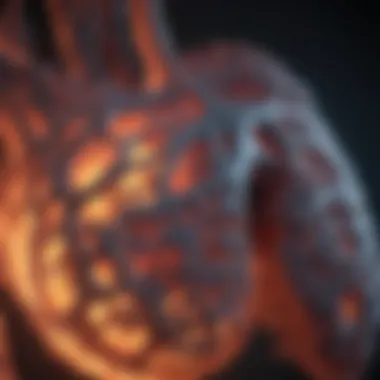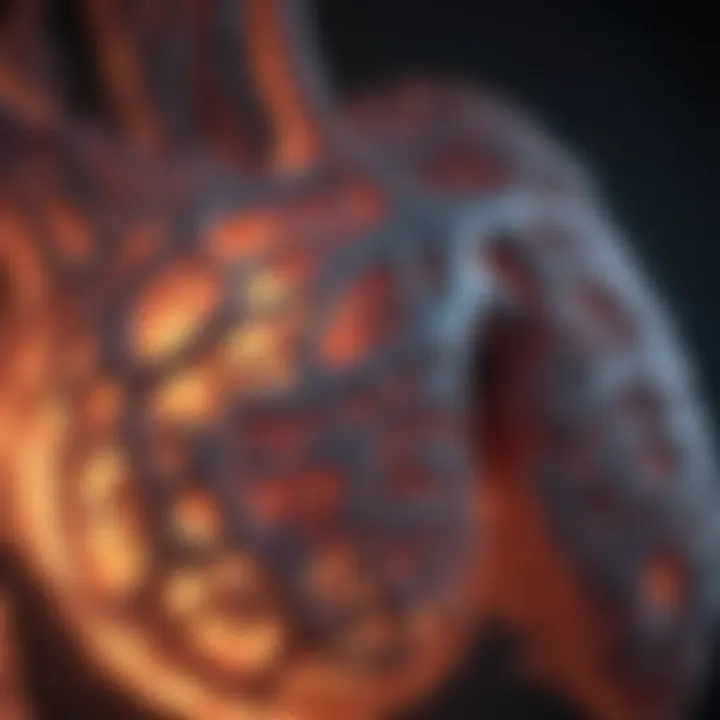Radiation Fibrosis and Its Impact on Life Expectancy


Intro
Radiation fibrosis is a significant consequence of radiotherapy, primarily affecting patients undergoing treatment for cancers located within or near the thoracic cavity. This condition is marked by the thickening and stiffening of lung tissue, leading to a decline in pulmonary function. Understanding the implications of radiation-induced lung fibrosis for life expectancy is crucial for both patients and healthcare professionals.
Several factors contribute to the development of fibrosis, such as the dose and type of radiation received, the patient's overall health, and pre-existing lung conditions. In this article, we will explore how these elements intertwine, along with the symptoms, diagnosis, and treatment options available for individuals afflicted with this condition.
Moreover, we will address psychosocial aspects, emphasizing the importance of supportive care for patients and their families. As research advances, the need for a comprehensive understanding of radiation fibrosis grows, given its significant implications for both individual patient care and broader medical practices.
Through our exploration, we aim to provide valuable insights into the complex relationship between radiation-induced lung fibrosis and life expectancy.
Prolusion to Radiation Fibrosis
Radiation fibrosis of the lung is a significant topic in the landscape of oncological care. Understanding this condition is essential for patients who have undergone radiotherapy for thoracic malignancies. The consequences of radiation therapy extend beyond tumor control; they impact the quality of life, pulmonary function, and ultimately, life expectancy. As patients live longer post-treatment, awareness of potential late effects like lung fibrosis has become more pertinent. This section will shed light on the implications of radiation fibrosis, providing vital insights for both patients and healthcare professionals.
Definition of Radiation Fibrosis
Radiation fibrosis is defined as the formation of fibrous connective tissue in the lungs following exposure to ionizing radiation. This condition typically develops as a late effect of radiotherapy and is characterized by an abnormal healing response, where normal lung tissue gradually becomes stiff and scarred. The process involves complex biological changes including cellular injury and inadequate repair mechanisms in the lung parenchyma. Clinical assessments often reveal a decrease in lung volume and diffusing capacity, impacting respiratory health.
Historical Perspective
The history of radiation fibrosis reflects advancements in cancer treatment but also highlights the associated risks. Initial uses of radiation therapy in the early 20th century lacked an understanding of long-term effects. Over decades, as radiotherapy techniques improved, physicians began to document the emergence of lung fibrosis. Articles from the mid-1900s increasingly described patients who developed pulmonary issues after thoracic irradiation.
Research in the latter half of the 20th century focused on understanding dose-response relationships, leading to better techniques that aimed to minimize lung exposure. Recent studies indicate a more refined comprehension of the pathophysiology of radiation-induced injuries, advocating for ongoing research into predictive models and strategic treatment plans.
"Recognizing the late effects of radiation therapy, including lung fibrosis, is crucial for improving patient outcomes and quality of life."
In summary, radiation fibrosis of the lung represents a critical concern that arose with the evolution of cancer therapies. Enhanced understanding of the condition serves to better inform both clinical practices and patient awareness.
Pathophysiology of Radiation-Induced Lung Fibrosis
Understanding the pathophysiology of radiation-induced lung fibrosis (RILF) is crucial. This section explores the biological processes that lead to fibrosis following radiation exposure. Knowing these details helps professionals and researchers understand how to prevent or treat this complication. Moreover, it gives insight into the unique challenges faced by patients, which is key for improving their care and outcomes.
Mechanisms of Fibrosis Development
Cellular Injury and Death
Cellular injury and death are primary contributors to radiation-induced lung fibrosis. When radiation penetrates lung tissue, it causes damage to cells, including epithelial and endothelial cells. This damage leads to cell death, triggering a series of biological responses. The key characteristic of this process is that it does not only affect the immediate area but can also provoke systemic reactions in the lung environment.
The benefit of understanding cellular injury lies in the potential for targeted interventions. By focusing on ways to repair or protect these cells, we can mitigate the long-term impact of radiation. Notably, the unique feature of cellular injury is its ability to initiate processes that lead to inflammation and fibrosis. This has both advantages and disadvantages. The advantage is that recognizing such injury allows for early diagnosis and potential treatment options, while the disadvantage is the complexity involved in fully reversing damage once it occurs.
Inflammation and Repair Processes
Following cellular injury, inflammation and repair processes come into play. Inflammation is a response designed to heal tissue. However, in the case of radiation-induced lung fibrosis, this response can become maladaptive. Chronic inflammation can lead to excess collagen deposition, which is a hallmark of fibrotic tissue. A key characteristic of inflammation in this context is its dual role; it can be both protective and damaging.
This focus on inflammation is beneficial because it highlights possible therapeutic targets. It allows for the consideration of anti-inflammatory strategies in managing RILF. Unique in this process is the balance required between promoting healing and preventing excessive fibrosis. This balance has advantages in developing treatments, but it also has disadvantages, as patients may respond differently based on individual biological factors.
Role of Radiation Dose and Technique
The role of radiation dose and technique is vital in determining the extent of lung injury. High doses of radiation are more likely to result in significant lung damage, often leading to severe fibrosis. Moreover, the planning and delivery techniques used in radiation therapy can influence the degree of exposure to healthy tissue. This aspect underscores the importance of precise radiation targeting to minimize unintended damage.
In the context of treatment planning, understanding the role of both dose and technique can enhance patient safety. It is key to improving clinical outcomes and ensuring specific treatment protocols are adjusted based on individual patient conditions. The relationship between dose, technique, and outcomes is complex, warranting careful evaluation in clinical practice.
"A well-planned radiation therapy approach can significantly reduce the risk of lung complications and improve the quality of life for patients."
Through ongoing research, advancements in radiotherapy techniques continue to emerge, aiming to reduce the incidence of radiation-induced lung fibrosis while maintaining treatment efficacy.
Clinical Manifestations of Lung Fibrosis
The topic of clinical manifestations of lung fibrosis is central to understanding the ramifications of radiation-induced damage. Recognizing these manifestations facilitates early diagnosis and effective management strategies. This section elaborates on the symptoms and differential diagnosis, helping patients and healthcare providers navigate the complexities of the condition.


Symptoms Overview
Respiratory Symptoms
Respiratory symptoms serve as the most prominent clinical manifestations of lung fibrosis, including chronic cough, dyspnea, and decreased exercise tolerance. These symptoms profoundly affect the quality of life for patients. Chronic cough can become a persistent annoyance, while dyspnea may escalate into severe breathing difficulties, limiting daily activities. A key characteristic of respiratory symptoms is their gradual worsening, often leading to misinterpretation as general aging or other conditions.
Patients may initially dismiss dyspnea during exertion, unaware that it may indicate lung fibrosis progression. For this article, focusing on respiratory symptoms is vital because they form the foundation for clinical assessment and intervention.
One unique feature of respiratory symptoms is their variability. For some patients, symptoms may fluctuate based on environmental factors or physical activity. This variability poses both advantages and disadvantages in recognition and management. On one hand, the fluctuations can distract from the severity of the underlying condition; on the other, they present opportunities for tailored therapeutic approaches that account for individual symptom profiles.
Systemic Effects
Systemic effects encompass symptoms that extend beyond the lungs, impacting overall health. Fatigue, weight loss, and muscle weakness are common systemic effects experienced by patients with lung fibrosis. These symptoms are crucial to consider as they can be indicative of disease progression and overall prognosis.
The systemic effects highlight the interconnectedness of respiratory health with global health status. A significant characteristic of systemic effects is their nonspecific nature, making them challenging to link directly to lung fibrosis without comprehensive evaluation. This characteristic elevates the importance of recognizing these effects in the broader context of patient care.
In this article, integrating systemic effects is beneficial as it underscores the multifaceted impact of radiation-induced lung fibrosis. A unique feature of these systemic symptoms is their potential to lead to complications such as malnutrition and depression, particularly if not adequately addressed. Awareness of systemic effects allows for a more holistic approach to treatment, incorporating nutritional support and mental health interventions, which are often neglected in clinical settings.
Differential Diagnosis
Differential diagnosis in lung fibrosis is a critical component that ensures accurate identification and management. Several conditions may exhibit similar clinical presentations, such as idiopathic pulmonary fibrosis, pneumonia, or lung cancer. Effective differentiation hinges on thorough auscultation, imaging studies, and patient history.
Unique features in differential diagnosis comprise specific clinical markers and diagnostic tools that aid clinicians. High-resolution computed tomography (HRCT) scans can reveal characteristic patterns in lung tissue, providing valuable insights.
Immediate and accurate diagnosis is crucial for implementing appropriate treatment strategies, which can significantly affect outcomes. The overlap of symptoms across conditions necessitates an astute clinical approach to timely diagnosis and intervention.
Impact of Pre-existing Conditions
The significance of pre-existing conditions should not be overlooked when discussing radiation fibrosis of the lung. The presence of conditions such as chronic lung diseases and cardiovascular issues can significantly influence the prognosis and overall impact of lung fibrosis. Understanding these interactions helps craft more effective diagnostic, therapeutic, and supportive strategies for affected individuals.
Chronic Lung Diseases
Patients with pre-existing chronic lung diseases, like chronic obstructive pulmonary disease (COPD) or asthma, may face greater challenges when developing radiation-induced lung fibrosis. These conditions can complicate the lung’s ability to handle additional damage from radiation. As a result, even minimal radiation exposure could exacerbate existing issues, leading to pronounced symptoms such as chronic cough, dyspnea, and increased susceptibility to infections.
Furthermore, the interplay between lung fibrosis and chronic lung disease can result in a more severe decline in pulmonary function. Studies show that the extent of lung damage caused by radiation is often potentiated in patients already suffering from chronic conditions. Here are important considerations related to this aspect:
- Increased Symptom Burden: Patients may experience overlapping symptoms from both their chronic condition and radiation fibrosis, complicating treatment and management.
- Worsening Respiratory Function: Chronic lung diseases may already compromise lung function, making any additional fibrotic changes more significant and detrimental.
- Complicated Treatment Options: The presence of chronic illness narrows down treatment options, as some therapies for radiation fibrosis may not be advisable for patients with an unstable chronic condition.
Cardiovascular Implications
The cardiovascular system is often impacted by lung conditions, including those worsened by radiation fibrosis. The heart and lungs work closely together, and issues in one often lead to complications in the other. Patients with pre-existing cardiovascular disease may experience an increased risk when they develop lung fibrosis after radiotherapy. This risk is attributed to several factors:
- Systemic Inflammation: Radiation can trigger systemic inflammatory responses, influencing cardiovascular health negatively.
- Increased Workload on the Heart: Fibrotic changes in the lungs can impact oxygenation and lead to increased strain on the heart, particularly in individuals with pre-existing heart issues.
- Higher Mortality Rates: Research indicates that patients with concurrent cardiovascular problems and lung fibrosis have a higher mortality rate. The combination of these conditions often suggests a poorer prognosis overall.
"Understanding the interactions between lung fibrosis and pre-existing conditions is crucial in optimizing patient care and survival outcomes."
Diagnostic Approaches
Understanding the diagnostic approaches for radiation fibrosis of the lung is essential for both accurate assessment and effective management of patients. In this context, identifying the right tools and methodologies helps form a clearer picture of the disease's progression. Diagnostics not only aid in establishing the presence and extent of lung damage but also contribute significantly to tailoring appropriate therapeutic interventions.
Imaging Techniques
CT Scans
CT Scans are widely considered a key tool in the evaluation of lung fibrosis. This imaging technique provides detailed cross-sectional images of the chest, allowing clinicians to visualize the structural changes in the lungs. One prominent characteristic of CT Scans is their high-resolution capability, which facilitates the early detection of fibrotic changes before they become significant. This is crucial for timely intervention and patient management.
Furthermore, CT Scans can help monitor the progression of the condition over time, revealing changes that may not be apparent in routine X-rays.
However, one unique feature of CT Scans is their ability to delineate between different types of lung tissue and abnormalities. This offers advantages in determining the specific nature of lung damage, whether it is due to radiation or other factors. Despite their benefits, CT Scans involve exposure to radiation, which is a consideration for patients who may already have received significant doses during treatment. Therefore, while they are beneficial, the risks and benefits need careful evaluation on a patient-by-patient basis.
Pulmonary Function Tests


Pulmonary Function Tests (PFTs) are another critical component in diagnosing radiation-induced lung fibrosis. They measure how well the lungs are functioning by assessing airflow and the ability to exchange gases. A key characteristic of PFTs is that they provide objective data regarding the degree of lung impairment. This data is beneficial for establishing baseline lung function and future evaluations of the patient's respiratory status.
The unique feature of PFTs lies in their non-invasive nature, making them a safer choice for patients who may already be vulnerable. They also allow healthcare providers to assess not only the presence of fibrosis but also its impact on lung function, which can inform management strategies.
However, while PFTs are informative, they can sometimes miss early-stage fibrosis unless combined with imaging techniques. Thus, using them in conjunction with CT Scans offers a more comprehensive approach in diagnosing and understanding the disease.
Biomarkers in Diagnosis
Biomarkers play a vital role in the diagnosis of radiation fibrosis. These biological indicators can help establish the presence of fibrosis before significant symptoms or imaging changes occur. Various studies suggest that specific markers can correlate with the extent of lung injury and inflammation, providing valuable insight into the disease’s progression.
- In addition, biomarkers can help differentiate radiation-induced fibrosis from other lung conditions, leading to more accurate diagnoses.
- However, the use of biomarkers is still under investigation and may not yet be available in routine clinical practice. Incorporating them into diagnostic strategies could enhance future understanding and treatment of lung fibrosis.
Therapeutic Interventions
Therapeutic interventions play a critical role in managing radiation fibrosis of the lung, addressing both symptoms and underlying causes of the condition. The focus of these interventions is to improve lung function, enhance quality of life, and alleviate the impact of fibrosis on overall health. Understanding the various forms of therapy can help clinicians and patients make informed decisions based on individual circumstances.
Pharmacological Treatments
Corticosteroids
Corticosteroids are anti-inflammatory medications commonly used in the treatment of lung fibrosis. They work by suppressing inflammation, which can help reduce the progression of fibrosis and relieve symptoms. The key characteristic of corticosteroids lies in their ability to modulate immune responses and decrease tissue swelling. This makes them a beneficial choice in managing radiation-induced lung damage.
The unique feature of corticosteroids is their rapid onset of action. Patients often experience noticeable relief from symptoms, such as coughing and breathlessness, shortly after beginning treatment. However, long-term use has disadvantages, including potential side effects like osteoporosis, weight gain, and increased susceptibility to infections.
Antifibrotic Agents
Antifibrotic agents are a newer class of medications specifically designed to target the fibrotic process. They work by interfering with the mechanisms that lead to the excessive deposition of extracellular matrix components, thus slowing down or potentially reversing fibrosis. Their main benefit is in reducing the progression of lung scarring, which can significantly improve lung capacity and overall functionality.
A notable aspect of antifibrotic agents is that they offer a targeted approach, specifically addressing the fibrotic changes rather than merely alleviating symptoms. Their primary advantage lies in the ability to preserve lung function over time. However, some patients may experience side effects such as gastrointestinal disturbances or liver enzyme abnormalities, which can limit their use and require careful monitoring.
Non-Pharmacological Approaches
Rehabilitation Techniques
Rehabilitation techniques encompass a series of therapeutic exercises and educational sessions designed to improve lung function and enhance physical endurance. These methods are essential in managing chronic conditions like radiation fibrosis. The key characteristic of these techniques is their focus on gradually increasing physical activity, tailored to the patient's capabilities and health status.
The unique feature of rehabilitation is its holistic approach, which not only addresses physical aspects but also mental resilience and patient education. Benefits can include improved exercise tolerance, better quality of life, and reduced symptom burden. However, adherence to rehabilitation programs can be a challenge for some patients, necessitating strong support from healthcare providers and families.
Nutritional Support
Nutritional support is another non-pharmacological approach aimed at enhancing overall health in patients suffering from radiation fibrosis. It plays a crucial role in increasing energy levels, promoting healing, and optimizing lung function. The key characteristic of nutritional support is its ability to address the dietary deficiencies that may arise due to illness or treatment side effects.
One unique feature is the focus on individualized dietary plans that cater to specific needs and preferences. Nutritional support can significantly improve a patient's resilience and overall outcomes. Still, there may be challenges in maintaining a balanced diet, especially in those experiencing appetite loss or gastrointestinal issues due to treatments. Regular consultations with nutritionists and caregivers can help to overcome these obstacles.
Conclusion: A multifaceted approach incorporating both pharmacological and non-pharmacological interventions is essential in managing radiation fibrosis of the lung. This ensures better patient outcomes and aids in improving both life expectancy and quality of life.
Life Expectancy in Radiation Fibrosis Patients
Understanding the life expectancy of patients with radiation-induced lung fibrosis is crucial for several reasons. It provides insights into how the condition affects overall health and quality of life. For patients, caregivers, and healthcare professionals, knowledge of life expectancy can inform treatment decisions and support planning. Furthermore, it highlights the ongoing need for research focused on improving outcomes for these patients.
Factors Influencing Life Expectancy
Extent of Lung Damage
The extent of lung damage plays a significant role in determining life expectancy for patients suffering from radiation fibrosis. This facet relates directly to the severity of the fibrosis and the overall extent of lung impairment. Patients with more extensive lung damage often experience greater functional decline. This can lead to complications such as respiratory failure, which significantly impacts longevity. A key characteristic of extent of lung damage is that it directly correlates with the volume of lung tissue that is affected by fibrosis. The more lung tissue involved, the worse the prognosis, making it a critical focus in managing the disease. The impact of this factor is substantial as it informs clinicians about potential interventions and patient management strategies that can be adopted.
Comorbidities and Age
Comorbidities and age are also critical elements affecting life expectancy in radiation fibrosis patients. Older age inherently comes with a decline in physiological reserves, making it difficult to withstand the additional stress imposed by lung fibrosis. The presence of other long-term conditions, such as heart disease or diabetes, can exacerbate the effects of lung fibrosis. This is because these comorbidities can contribute to decreased lung function and increase the risk of complications. A unique characteristic of considering comorbidities and age is that it emphasizes the need for a personalized approach to treatment, where the healthcare provider assesses multiple factors that may impact patient prognosis. Recognizing the interplay between age, comorbid conditions, and lung health can assist in crafting a more effective management plan for individuals afflicted by radiation fibrosis.
Survival Rates in Research Studies


Research studies have shown varying survival rates among patients with radiation-induced lung fibrosis. These rates depend on multiple variables, including the previously discussed extent of lung damage and the presence of comorbidities. Some studies suggest that individuals with minimal lung damage and fewer comorbid conditions can have a relatively favorable prognosis compared to those with severe fibrosis. For instance, a cohort study may highlight that patients with mild radiation fibrosis have a five-year survival rate that approaches that of the general population, while those with extensive damage face a significantly reduced survival rate. This type of data is vital as it not only paints a clearer picture of expected outcomes but also underscores the importance of early detection and intervention in improving life expectancy.
Psychosocial Considerations
Psychosocial considerations play a significant role in understanding the effects of radiation-induced lung fibrosis. This condition not only impacts physical health but also brings about emotional challenges that can affect the overall quality of life for patients. By addressing the psychosocial aspects, we can better assist individuals dealing with this complex health issue.
Emotional and Mental Health
The emotional and mental health of patients with radiation fibrosis is often compromised. Many individuals face feelings of anxiety, depression, and uncertainty as they grapple with their diagnosis. The fear of disease progression can lead to a constant state of stress, affecting their daily living.
Research indicates that emotional well-being is closely tied to physical health outcomes. Patients who experience psychological distress may also have poorer coping mechanisms, which can further complicate their recovery. Health care providers should recognize this emotional burden and consider integrating mental health support into the treatment plan. Some approaches that can be beneficial include:
- Cognitive Behavioral Therapy (CBT): This type of therapy can help patients reframe negative thought patterns and develop coping strategies.
- Mindfulness Practices: Techniques such as meditation and yoga can promote relaxation and reduce anxiety levels.
- Support Groups: These groups provide a space for sharing experiences and feelings, aiding patients in feeling less isolated.
"Emotional support is as critical as medical treatment for individuals with chronic diseases."
Support Networks and Resources
Establishing support networks is vital for individuals affected by radiation-induced lung fibrosis. Social support can provide both practical assistance and emotional encouragement. Patients benefit greatly from having a network of family, friends, and professional resources.
Some useful support strategies include:
- Engaging with Family and Friends: Open communication with loved ones about struggles and needs can foster emotional comfort.
- Professional Counseling: Access to mental health professionals who specialize in chronic illness can provide tailored support.
- Online Communities: Websites like Facebook and Reddit have groups focused on lung health where individuals can connect, share experiences, and gather information.
Moreover, healthcare providers should actively facilitate connections to support services that may include local health resources and information about available mental health professionals. This not only aids recovery but enhances the patient's sense of control and advocacy in their healthcare journey.
Incorporating psychosocial considerations into the treatment process allows patients to feel more grounded. It enables a holistic approach to care that addresses not just the physical symptoms of radiation fibrosis, but also the emotional challenges that come with it.
Future Directions in Research and Treatment
The future directions in research and treatment of radiation-induced lung fibrosis hold significant promise for better patient care and outcomes. Advancements in this field can open new avenues for therapies and preventive measures, which in turn, can improve life expectancy for individuals affected by this condition. Research efforts must address several key components that encompass innovative therapies, prevention strategies, clinical applications, and patient management.
Innovative Therapies
Innovative therapies aim to address the complex pathology of radiation fibrosis. Current treatments focus primarily on symptom management, with limited success in reversing lung damage. Emerging therapies include the use of
- Gene therapy: This approach targets specific genetic markers that contribute to fibrotic processes, allowing for a more individualized treatment plan.
- Stem cell therapy: By harnessing the regenerative capabilities of stem cells, researchers hope to repair damaged lung tissue and restore normal function.
- Novel antifibrotic agents: Drugs like nintedanib and pirfenidone, originally used for idiopathic pulmonary fibrosis, are being studied for their efficacy in managing radiation-induced fibrosis.
The exploration of combination therapies that integrate traditional pharmacological treatments with innovative techniques may yield enhanced therapeutic benefits. This holistic approach can not only address the symptoms but also combat the underlying mechanisms of fibrosis.
Studies on Prevention and Mitigation
Preventive measures play a crucial role in managing radiation fibrosis. Studies are underway to identify risk factors that predict lung fibrosis after radiotherapy. Key focus areas include:
- Dose optimization: Understanding the correlation between radiation dosage and lung damage could lead to improved treatment planning.
- Radiation techniques: Investigating different radiotherapy techniques, such as intensity-modulated radiotherapy (IMRT) or proton therapy, offers potential to reduce exposure to lung tissues.
- Pharmacological prophylaxis: Early administration of anti-inflammatory agents or protective agents post-radiation might mitigate the fibrotic response.
Long-term studies are essential to evaluate the effectiveness of these prevention strategies. Monitoring patient outcomes can guide clinicians in tailoring treatment plans that not only focus on cancer eradication but also on preserving lung function.
Epilogue
The topic of radiation-induced lung fibrosis and its impact on life expectancy is of significant relevance in the field of oncology and respiratory health. This article draws attention to the complex interplay between the effects of radiation therapy and the resultant pulmonary complications. Understanding these dynamics is crucial for both healthcare professionals and patients navigating the complexities of treatment options and long-term health outcomes.
Summary of Key Points
In summary, several key aspects have been highlighted throughout the article:
- Definition and Mechanisms: Radiation fibrosis is defined as cumulative scarring of lung tissue due to radiation damage. It often affects patients undergoing thoracic radiotherapy. Mechanisms of injury include cellular death and inflammatory processes, triggering fibrosis development.
- Clinical Manifestations: Symptoms can range from respiratory difficulties to systemic effects, impacting overall quality of life. Proper diagnosis requires differentiation from other lung conditions.
- Life Expectancy Factors: Various elements influence life expectancy, such as the extent of lung damage, age, and comorbidities. Research studies provide insight into survival rates, emphasizing the variability in outcomes based on individual patient circumstances.
- Psychosocial Considerations: Living with chronic conditions like lung fibrosis necessitates addressing emotional well-being and the importance of support networks.
- Future Directions: Innovative therapies and prevention strategies highlight a promising outlook for ongoing research in the field.
This comprehensive overview serves as an informative guide for understanding the implications of radiation fibrosis on life expectancy and patient care strategies.
Call for Multidisciplinary Approaches
Addressing radiation fibrosis effectively requires a multidisciplinary approach. It is imperative to integrate expertise from various fields including oncology, pulmonology, radiology, and psychosocial counseling. Collaborative efforts among these disciplines enhance diagnostic accuracy and treatment efficacy.
- Oncologists play a crucial role in planning radiation therapy, ensuring minimal dose exposure to healthy tissues.
- Pulmonologists focus on managing lung function, implementing appropriate interventions for respiratory support.
- Psychiatrists or psychologists help mitigate emotional distress that may arise from living with chronic lung conditions.
- Rehabilitation specialists can provide targeted physical therapy tailored to improve respiratory function and overall quality of life.
Such teamwork fosters a holistic framework, promoting comprehensive care that addresses both the physical and psychological aspects of living with radiation-induced conditions.







